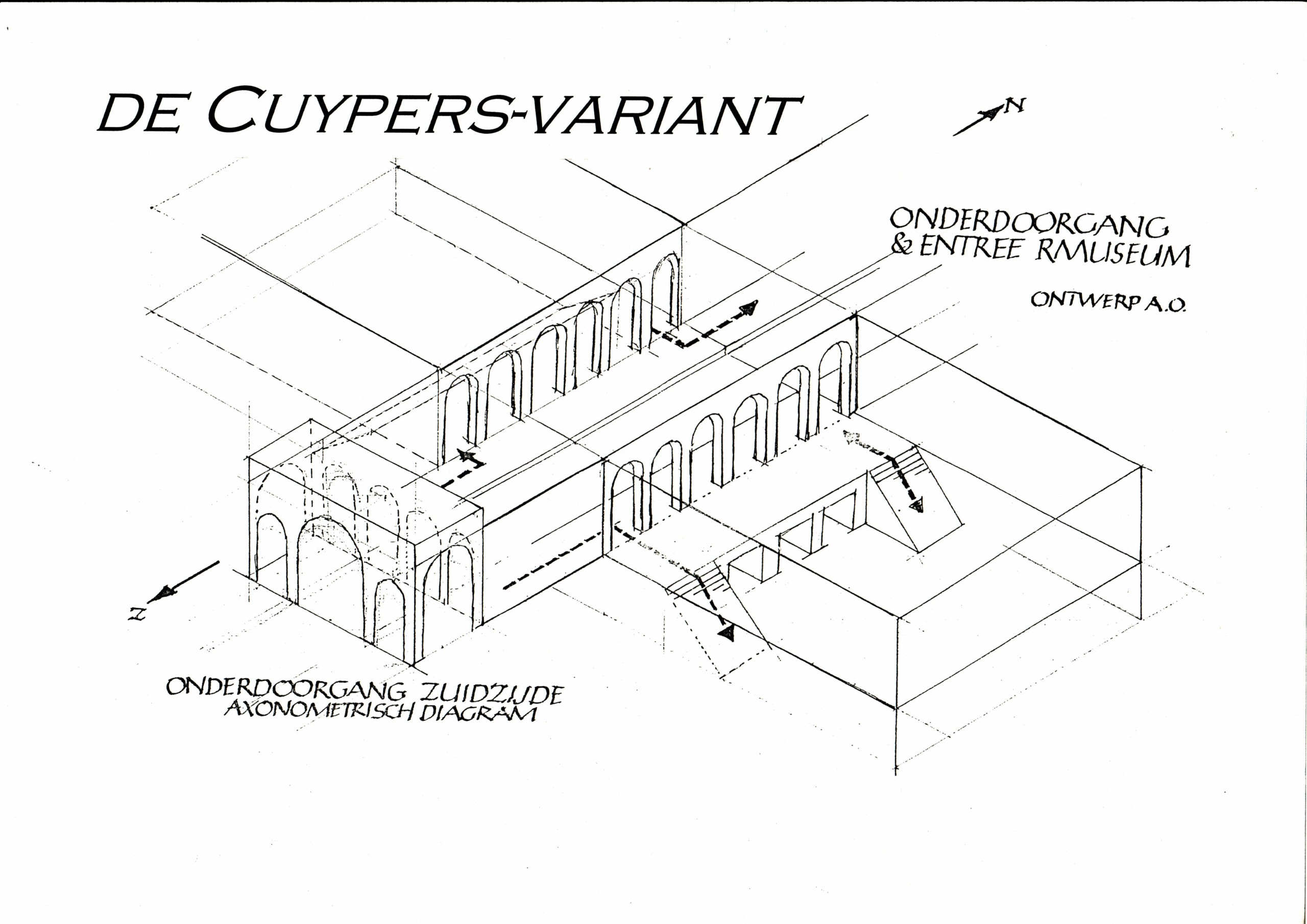Rijksmuseum passage: How one of the most precious bike paths in town nearly was lost
The bike path in the passage of Rijksmuseum is one of the most iconic cycle routes in the world. Maybe, it is also the strongest debated bike route. There have been several attempts to close the passage for cyclists. How could this happen in bike city Amsterdam? And how was the passage saved for cyclists? Here the stirring history of one of our most beautiful bike paths.
Historic passage
The museum was built in the 1880s on building land provided by the city of Amsterdam. In return, the city set the condition that a public passage to the new neighbourhoods south of the museum would be included in the building. The passage became an important and well used route for pedestrians, cyclists and cars. In 1931 cars were banned because the vibrations they caused would damage the building. A proposal to allow trams go through the passage was visualised but never materialised.

| Image: Cross section of the museum and the passage. By Cuypers, around 1890.
Connection or barrier?
While the passage is a connection for the city, it can be an obstacle to the museum building as it dissects the ground level floor. That is a reason why over the years, several museum directors have attempted to incorporate the passage in the museum. But they never succeeded. The city and Amsterdammers would not give away their beloved and well used passage.
In 1976 when the first draft for the main bicycle network was drawn up, the museum passage was an important part of the bike network. It rightfully still is. The passage is a safe, direct and comfortable bicycle connection used by thousands of cyclists every day. However, at the beginning of this century the bike path in the passage was disputed again.
Renovation plan: museum entrance or bicycle path?
Around 2000 a plan was proposed for a large-scale renovation of the museum. The chosen design included a new entrance to the museum in the centre of the passage, right in the place of the bicycle path. This plan was cause for a long and turbulent debate.
The architects and the museum claimed cyclists could easily share the space in the side aisles of the passage with pedestrians. But the Cyclists’ Union, concerned citizens and politicians were not convinced. They expected that combining over 15,000 cyclists per day with pedestrians in the 3.5 meter wide side aisles would likely lead to problems. These in turn could lead to cyclists being banned from the passage. The Cyclists’ Union and concerned citizens united in the action group Red de Onderdoorgang, Save the Passage.

| Image: Preliminary design for the passage, with issues mentioned by protesters. Image: Red de Onderdoorgang, around 2004. The mentioned issues in English from left to right: windows attract pedestrians; lockability stairwell problematic; 1. Too little space for pedestrians and cyclists, 2. Unnatural road layout.
Banning cyclists from the passage would not only eliminate one of the most beautiful bike paths in the city but also force cyclists to travel along uncomfortable d-tours. And cyclists and pedestrians would have to cross at complicated spot near Stadhouderskade.
Alternative entrance inside walls
In 2004 these objections led to a resolution by the district council who asked the museum to investigate an alternative option for the entrance. At first the museum claimed this was not possible but, when it was decided in 2005 that the public space of the passage could not be used for entrance stairs, an alternative was designed. Instead of the entrance in the centre, alternative entrances were positioned in the side walls of the passage. In 2009 a building permit was commissioned for this plan.

| Final design for passage, 2009. Photo: DO.

| Sketch of entrance that doesn’t take space of the passage. By action group Red de Onderdoorgang, (Save the passage), 2004.
Cycling in unaffected passage too dangerous?
In 2010 a new museum director took office. Though his predecessor had claimed that cyclists and pedestrians could easily share the space in the side aisles, the new director stated otherwise. He highlighted that the museum would attract so many visitors that cycling in the unaffected passage would be too dangerous. It would be better for cyclists to ride around the museum. Once again this stirred up debate and protest. Another research report was commissioned. Unlike the museum directors claims the research outcome showed it is safest for both cyclists and pedestrians to have cyclists riding through the passage.
Cyclists in the middle
Finally, the passage was built as planned in 2005. With entrances in the side walls and a clear and understandable layout: With cyclists in the middle and pedestrians on the sides. The sidewalks extend 1 meter beyond the pillars for optimal view between cyclists and pedestrians.
On 13 May 2013, after nearly 10 years being closed for the renovation, the passage re-opened. Observations by the road safety commission confirmed it all worked well. Now thousands of cyclists and pedestrians use the practical and beautiful route through the passage on a daily basis.
An interesting article by Bicycle Dutch about the passage can be found here.







